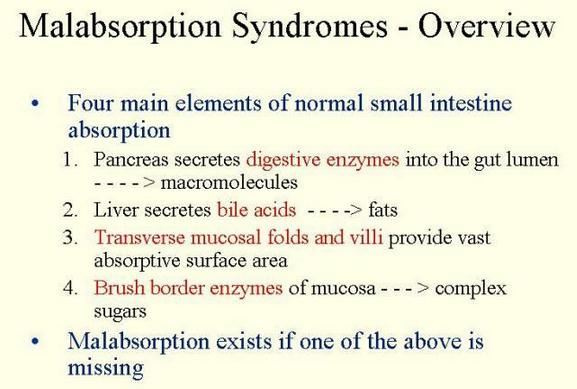Malabsorption Syndrome – Causes, Symptoms, Treatment, Prognosis
Malabsorption syndrome is a collection of signs and symptoms that alters the ability of intestines to absorb nutrients and minerals especially fat-soluble vitamins A, D, E, K and macronutrients. The intestine cannot absorb properly because of the underlying conditions associated with this.
Malabsorption has many causes including bowel resection, vascular impairment, gallbladder disease and lymphatic disease. This condition can be acquired or congenital that really affects the transportation of nutrients in the body.
Condition Leading to Malabsorption Syndrome
1.) Celiac Disease– also known as gluten-sensitive enteropathy. It is a disease of the small intestine mark by the atrophy of villi and microvilli. It develops to an immune-mediated inflammatory response to gluten. Gluten is a protein commonly found in barley, rye, oats and wheat. The cause of this disease is unknown.
2.) Short bowel syndrome– happens when large portion of the small intestine is remove. It minimizes the area that absorbs nutrients.
3.) Lactose intolerance- is a condition wherein a person cannot tolerate in taking those products that contains lactose especially in milk.
4.) Whipples Disease– this condition is mostly affecting men in middle ages. It is rare condition that cause by bacterial infection.
5.) Topical sprue- a rare condition that is caused by food toxins.
6.) Short bowel syndrome- this condition lessens the surface area of the bowel that is responsible for nutrient absorption.
7.) Pancreatitis- this is a condition where the pancreas is infected and cannot absorb nutrients.
8.) Cystic fibrosis- the second widest condition causing malabsorption syndrome. This an autosomal recessive disorder affecting the exocrine glands.
Factors Affecting Malabsorption Syndrome
Several risk factors are being studied to know the morbidity of the syndrome.
- Age (newborn and infants are most affected)
- Race (common in United States, Eskimos in Canada, Greenland, Asia and Africa)
- Sex (females highly acquire this condition)
- Family history
- Usage of specific drugs
- Surgery
- Excessive alcohol intake

Signs and Symptoms
- Fatigue
- Steatorrhea, Diarrhea, Abdominal distention, Foul-smelling stools, Abdominal bloating
- Anemia, Edema
- Musclecramps, Muscle Wasting
- Skin irritation
- Abnormal Heart rate
- Low-grade fever
- Pain in the joints
- Weight loss
- In some cases, radiation therapy is considered one of the reasons in this condition. Also antibiotics can affect a normal bacterium that resides in the intestine.
Laboratory and Diagnostic Testing
Some tests are required to perform in order to know and diagnose the condition. These test were listed here as follows:
- Blood testing such as:
-serum sodium, potassium and chloride
-serum calcium and serum cholesterol
-serum protein and albumin test
-vitamin A indicator test (conforming beta-carotene)
- Schilling test (skin testing)
- D-xylose test
- Fluids and fluid retention monitoring test
- Electrolytes balance monitoring
- Magnetic Resonance Imaging (MRI)
- CT scan is also done
- Barium enema
- Stool collection monitoring for 72 hours
- Biopsy of the intestine
- X-ray of gastrointestinal tract
- Shortness of breath
Treatment Modalities
Treatment also depends on the underlying cause. Different approach is done to evaluate the effectiveness of the treatment. These are the following:
- Careful monitoring is done to prevent further medical illness
- Essential vital signs is established
- Assess for any signs of nutrients and mineral depletion
- Hospitalization is needed if nutrient imbalance occurs.
- Symptomatic approach is perform to alleviate discomforts
- Oxygen is administered for shortness of breath
- Dietary modifications
- Supplemental vitamins and minerals are needed
- Monitor frequently the growth of the patient
- Monitor characteristics of stool and frequency of it
- Supportive treatment of family is recommended
- Daily oral intake of iron and folic acid is instructed to the patient
- Anti-spasmodics to lessesn the muscle cramping
- If the patient have cystic fibrosis and pancreatitis they are given pancreatic supplement
- Dietary modification especially those who have lactose intolerance are instructed
- Careful monitoring to ensure the stable condition of the patient
- The expected outcome of this treatment varies on the prognosis of the person. Following proper treatment regimen is also recommended for the success of the treatment. Positive outlook in life can be a big help in controlling and minimizing the disease.
Disease Prognosis and Mortality
The frequency of this syndrome depends upon the underlying diseases. About 1% of the population can manifest this syndrome. This is not only by genetic means but this can also be acquired most especially by children of young age. Best to describe is protein that comes from cow and soy milk. It contains this macronutrient that a young kid cannot absorb properly. This on and off occurrence can lead to enteritis. This is another form of inflammation in the colon. A public demonstration of this condition differs in line with the specific disease condition. Depending on the particular disease, the mortality would be determined. If it is acquired congenitally, it will occur about 24 to 25 out of 100,000 live births with the highest mortality rate. The underlying should be determined first before it’s too late for the affected person to survive.
References:
- http://emedicine.medscape.com/article/931041-overview#a0199
- http://www.faqs.org/health/topics/3/Malabsorption-syndrome.html#xzz2f1Jby0VZ
- http://medical-dictionary.thefreedictionary.com/Malabsorption+Syndrome
- http://www.nlm.nih.gov/medlineplus/malabsorptionsyndromes.html